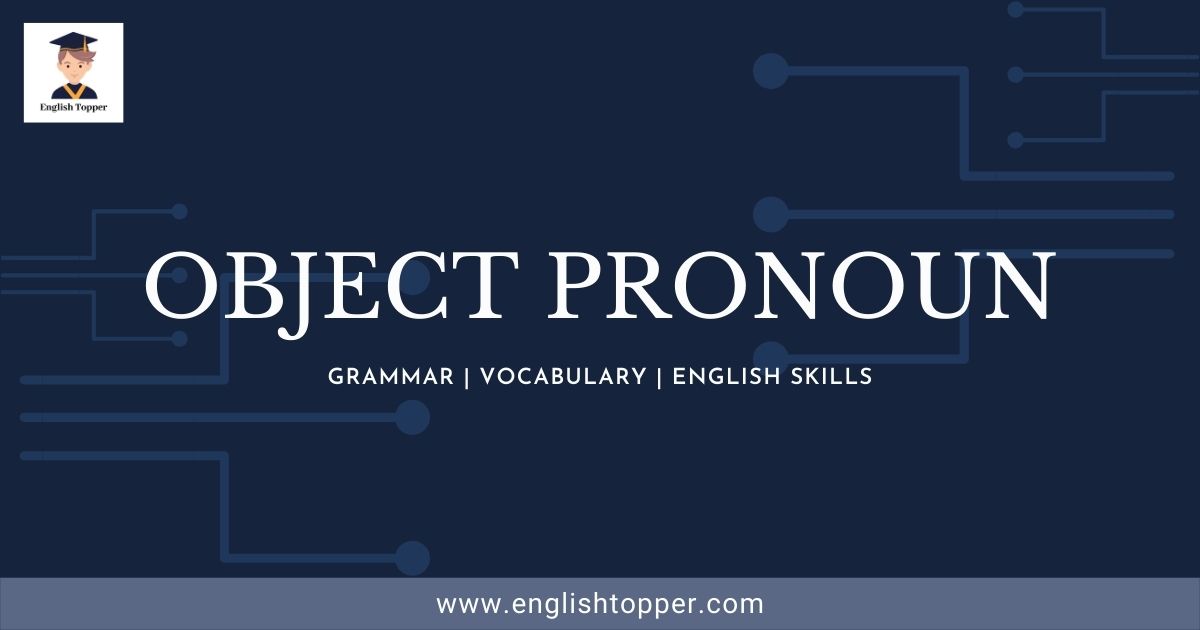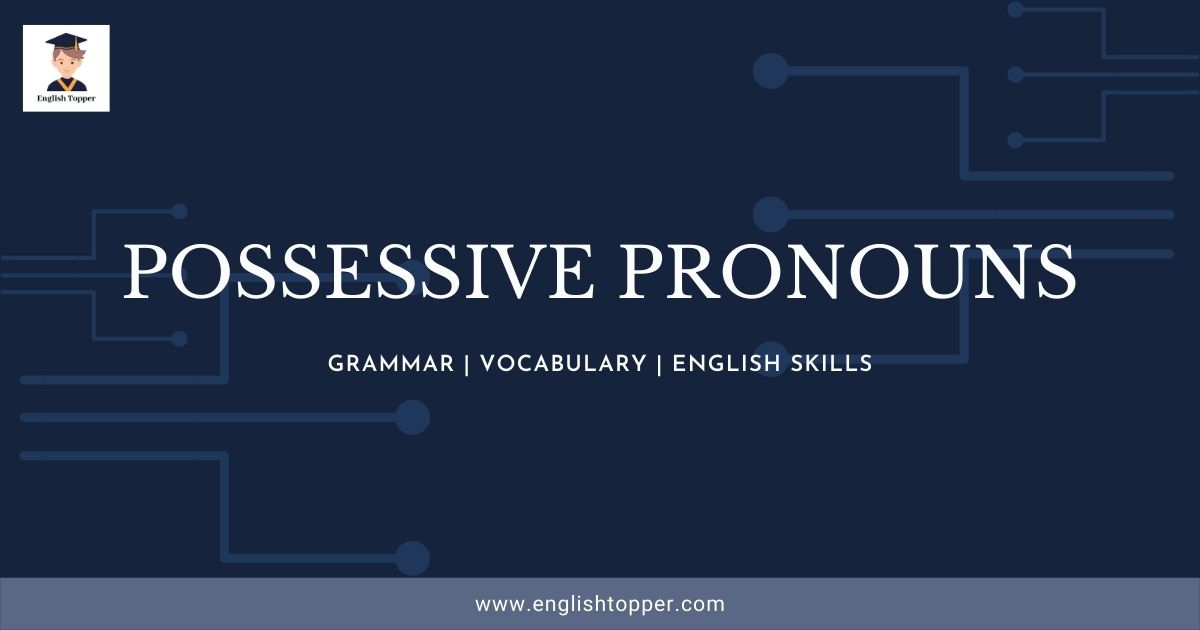|
Getting your Trinity Audio player ready...
|
Table of Contents
What is Personal Pronoun? (with examples)
A Personal Pronoun is a word that is used to simply replace the name of a person, thing, etc. It is one of the types of Pronouns.
Generally, Pronouns are mainly used to replace the name of anything (like person, thing, etc) in the sentence. In other words, it replaces Noun or Noun Phrase.
And the functionality of the Personal Pronoun is similar to Pronoun, but Personal Pronoun mainly concentrates on the number of persons, gender, etc.
So, Personal Pronouns are mostly used in 4 cases. Those are,
- Person: First Person (or) Second Person (or) Third Person.
- Number: Singular (or) Plural.
- Gender: Male (or) Female (or) Neutral.
- Case: Subject (or) Object.
Some of the Personal Pronoun examples are I, we, him, her, us, them, they, his, her, etc.
Here are some Personal pronoun example sentences to refer to and understand the concept.
- They usually prefer me to manage their work.
- She likes her house very much.
- He doesn’t like his father’s advices on investments.
- We would like to visit your house this sunday.
- He don’t trust them from now on.
Also Read: What is a Pronoun? | Pronoun Definition and Examples (2021)
Different Factors of Personal Pronouns
Personal Pronoun in terms of Person (Point of View)
Previously, we had discussed the 4 cases in which the number one case is about the person. Now, we will learn in detail about it.
So, it is used based on the Person’s Point of View (POV) such as,
- First Person View
- Second Person View
- Third Person View
The First Person View represents the person who is speaking. That is the Pronouns that are used refers to the person who is speaking.
For example, I and we.
- I like to eat pizza.
Here, “I” represents the self-view of the person.
The Second Person View represents the person who is addressing to. That is the Pronouns that are used refers to the person who is addressing another person.
For example, you.
- Why you didn’t come to college yesterday?
The Third Person View represents the person who is neither speaking nor addressing to. That is the Pronouns that are used refers to the person who is another person.
For example, he, she, it and they.
- She doesn’t like to attend any party.
Personal Pronoun in terms of Number
The 2nd case is about the number of people, things, etc.
So, it is used based on the number such as one (Singular) and more than one (Plural) person, things, etc.
For example,
- Singular: I, you, he, she, etc.
- Plural: we, they, us, etc.
Personal Pronoun in terms of Gender
The 3rd case is about gender. So, it is used based on the gender of a person. This case is also used for things.
- Male (he, him)
- Female (she, her)
- Neuter (it)
Example Sentences:
- He is very smart.
- She wants to become an entrepreneur.
Note: To refer to a single thing, we commonly use “it” in the sentence. However, there are a few exceptions. We sometimes refer animals with he/him (or) she/her. This can also be used for,
- Domestic Pets.
- Ships.
- Some Countries.
- Vehicles or some type of vessels, etc.
For example:
- This is my dog Tommy. He is very loyal to me. (Domestic Pet)
- The Titanic was a great ship but she sank in the year 1912. (Ships)
- Thailand has now unlocked her border with Cambodia. (Country)
- This is my favourite car and I like the colour of her. (Vehicles)
Personal Pronoun in terms of Case
Personal Pronouns can be either Subject or Object in a sentence. Subject Pronoun is said to be in Nominative Case and Object Pronoun are said to be Objective Case.
Nominative Case is one of the cases used for Noun and Pronoun in the sentence. It is actually the subject of the verb.
Objective Case is another type of case in which it is used to refer to when a noun or pronoun is used as an object. Here, the object can be Direct, Indirect or Object of Preposition.
So, overall there are two types of Personal Pronouns used in the sentence. Those are,
- Subject Case
- Object Case
We will learn about this in detail in the coming topics of this article.
Reference Table on Personal Pronoun (based on the four cases)
| Number | Person | Gender | Subject Case | Object Case |
| Singular | First | Male/Female | I | me |
| Singular | Second | Male/Female | you | you |
| Singular | Third | Male | he | him |
| Singular | Third | Female | she | her |
| Singular | Third | Neuter | it | it |
| Plural | First | Male/Female | we | us |
| Plural | Second | Male/Female | you | you |
| Plural | Third | Male/Female/ Neuter | they | them |
Different Types of Personal Pronouns
Here we are going to learn 4 different types of Personal Pronouns. Those are,
- Subjective Personal Pronouns
- Objective Personal Pronouns
- Possessive Personal Pronouns
- Reflexive Personal Pronouns
Subjective Personal Pronouns
We had previously discussed Subjective Personal Pronouns which is also called Nominative Case. Let us recall the topic.
It usually indicates that the Pronoun is acting as the Subject of the Verb.
Examples of Subjective Personal Pronouns are “I”, “you”, “he”, “she”, “it”, “we” and “they”.
Here are the example sentences of Subjective Personal Pronouns.
- I am happy today because I had won the lottery.
- Do you speak English?
- He is good at mathematics.
- She is interested to join today’s event.
- It is raining today.
- We are having a meeting tomorrow.
- They are planning for a holiday trip.
Objective Personal Pronouns
We also discussed this topic previously, which is also known as Objective Case.
Objective Case is used for nouns and pronouns that function as objects in the sentences. There are three types of objects in it. Those are,
- Direct Object
- Indirect Object
- Object of a Preposition
Examples of Objective Personal Pronouns are “me”, “you”, “him”, “her”, “it” and “them”.
- Can you help me in finishing this project?
- There are lot of things to know about him.
- I want her help to cook the dish.
- I want them to attend today’s birthday party.
Also Read: What is a Direct Object in a Sentence? (Guide 2021) and What is an Indirect Object? (Definition & Examples 2021)
Possessive Personal Pronouns
Possessive Personal Pronouns are used to represent who owns it and also refer to the owner of a thing, place, etc.
Some of the examples are his, hers, mine, its, our and theirs.
Examples Sentences:
- This big mansion is mine.
- This is his suitcase.
- This is her house.
- They have to complete their own work.
- This fish is so big for its aquarium.
Reflexive Personal Pronouns
Reflexive Personal Pronoun is a type of Personal Pronoun that is used to refer to self. For example myself, yourself, themselves, himself, herself, itself, ourselves, etc.
Example Sentence:
- Raju wants to learn swimming himself.
- She doesn’t like to work herself alone.
- I believe myself that I am going to win this game.
- You need to learn yourself on how to drive a car.
- We need to complete this project ourselves.
- One should work hard on their dreams and success will come itself to you.
Summary (What is Personal Pronoun?)

So, here is the summary of what we had learned till now.
- Personal Pronoun is a type of Pronoun used to replace name (Noun) of the Subject in the sentence.
- So, Personal Pronoun have 4 factors such as person, gender, number and case.
- In person’s point of view, there are 3 types such as First, Second and Third.
- In terms of Gender, there are 3 types such as Male, Female and Neuter.
- In terms of Number, there are 2 types. One is Singular (One) and another is Plural (more than one).
- There are 4 different types of cases which are used in Pronouns. Those are Subjective, Objective, Possessive and Reflexive Personal Pronouns.
If you are interested to learn more, then you can refer to Wikipedia here.
I hope that you understood the topic “What is an Indirect Object?”. If you still have any doubts, then comment down below and we will respond as soon as possible. Thank You.
Liked this article? Please do share this article with others 🙂






[…] Personal Pronoun | (Definition & Examples) | Full Guide 2021 […]
[…] Personal Pronoun […]